HNV-Link Newsletter #5 (2018)

HNV-Link project aims to identify and share innovations that support farming systems in areas of high biodiversity across Europe. It supports efficient innovation transfer between its 10 Learning Areas.
Learning and building capacity for High Nature Value farming
After having created the Innovation Compendium, a unique compilation of grassroots innovation examples relevant to High Nature Value (HNV) farming systems, the HNV-Link network has chosen ‚Äúcross-visits‚ÄĚ as a method to foster innovation exchanges within and among the Learning Areas.
In this Newsletter, we introduce HNV-Link project’s cross-visit approach and present highlights from several visits. We also present the participatory approach of the project and its two major outputs: HNV-Link’s interactive map of innovations and educational materials. As always, we are pleased to report updates from many activities within the Learning Areas. Finally, the registration for the final conference is open!
Project approach
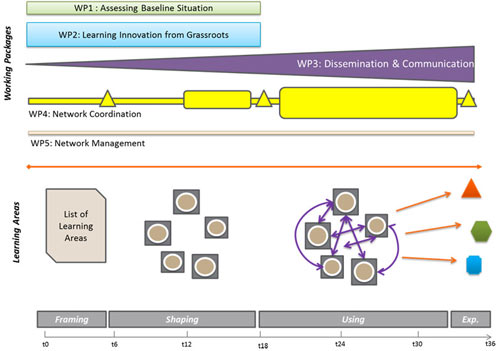
HNV-Link project is now at the end of its ‚ÄúUsing the Network‚ÄĚ phase and entering the last stage of ‚ÄúExpanding the Network‚ÄĚ. This means increasing focus at building new innovation partnerships and other applied research and development projects to fill the identified gaps, related awareness-raising, and feeding into policy.
The project approach is already proving useful for other initiatives in and outside the 10 Learning Areas. For example, Mary Mulvey, Upland Network Coordinator, reports that The Upland Study Grant Scheme (September 2018), funded by The Heritage Council in Ireland, benefitted from resources and methodology on cross-visits developed by HNV-Link: ‚Äúfrom trip design to reporting, the design of our Scheme was greatly enhanced by shared experiences.‚ÄĚ
Conference
The HNV-Link project will hold its final conference on 31 January 2019 at CIHEAM-IAMM in Montpellier. The title of the conference is ‚ÄúInnovation to sustain High Nature Value Farming: Who needs to do what?‚ÄĚ. The objectives are to:
- raise awareness of the importance of HNV farming to society;
- share HNV-Link’s achievements, insights, and recommendations;
- foster the exchange of ideas on ways to enhance the sustainability of HNV farming systems;
- link the 10 HNV-Link Learning Areas with other HNV farming territories and revive the HNV farming community cooperation dynamics.
The conference is free of charge (the organisers will pay for the venue, catering, etc.), but participants have to cover their travel and accommodation costs.
Please register before 31 December 2018. In case of later cancelation, please, inform the organisers by email [puigdemorales(at)iamm.fr].
See conference programme for further information.
Participatory approach
In line with the framework of Horizon 2020 to foster innovation, HNV-Link is a true multi-actor project with the primary aim of networking and spreading innovation for strengthening High Nature Value farming across Europe. Each of the 10 Learning Area partners has expertise in participatory approaches with multiple stakeholders. The principle of participatory multi-actor engagement has been applied throughout the life of the project, which is richly illustrated with facts and testimonies on the respective pages of each Learning Area.
Exchanging innovations: Cross visits

The Learning Areas developed their Innovation Action Plans for adapting and transferring innovations from one Learning Area to another. An important part of the Action Plans are the cross-area visits. Their aim is to support peer-learning through exposure to promising HNV farming innovations that could be further adapted for implementation in the teams’ home areas. Cross-visits started in May 2018 and are continuing till the end of the year.
A wide range of rural development actors have participated in cross-visit teams. Each team is producing a cross-visit report highlighting their most valuable findings and learning experiences, as well as ideas for further work inspired by the visit. The participating organisations are disseminating their findings across their own networks. In addition to providing inspiration and learning, cross-visits have resulted in strengthened HNVf networks including, for example plans for future cooperation between regions though joint funding applications. Videos, photographs, and reports of the cross-visits are here. It is well worth listening to reflections from participants from both hosts and visiting teams!
‚ÄúI think these kinds of exchanges for the HNV-Link project are key to sharing best practices, to invite us to think out of our conventional boxes and to support the development of more integrated agri-food systems, which should meet the demands of the society for healthier foods, healthier ecosystems, and better social standards. This exchange experience is crucial for the project‚ÄĚ. - Fabrice Gouriveau, HNV-Link Project Coordinator on a video
Examples of learning through cross-visits
Cross-visits have occurred with neighbours and farther abroad. For example, the UK team welcomed Welsh and Irish colleagues, and Romanian and Bulgarian teams have visited each other. In these cases, the choice for visits was made based on similar socio-economic settings in hope of smooth transfers of suitable innovations. A Portuguese team of 20 participants with diverse backgrounds (supported by Leader funding) visited Ireland, where the hosts organised a workshop focused on developing a results-payment payment approach for the Portuguese Montado system. Sweden hosted teams from the UK, Bulgaria, and Greece, while Greece hosted their colleagues from Bulgaria. Both as visitors and hosts, the Greek team shared their example of high-tech monitoring of herds in the extensive grazing areas. Visitors to Sweden were impressed by the close cooperation of farmers and officials for developing HNV farming solutions. Photo and video reportages are available under the social media hashtags #HNVnetwork and #CrossVisits, and from www.hnvlink.eu/activities/cross-visits/.
An important lesson of the cross visits is that participants can learn (and be inspired!) by innovations both from countries with similar biogeography or socio-political context, as well as from countries that are quite different from their own - as expressed, for example, by Gwyn Jones from the UK at his team’s trip to Sweden. For more reflection videos, explore the Cross-visits playlist on HNV-Link’s YouTube channel.
The most recent cross-visits are Croatia team visiting Romanian colleagues October 1-4 and the teams from Spain and Greece visiting France on October 3-5.
The HNV-Link team is working on a Methodological Guide to conducting cross-visits within and across countries. The guide is expected to be online in early 2019.
Interactive map of innovations for HNV farmland
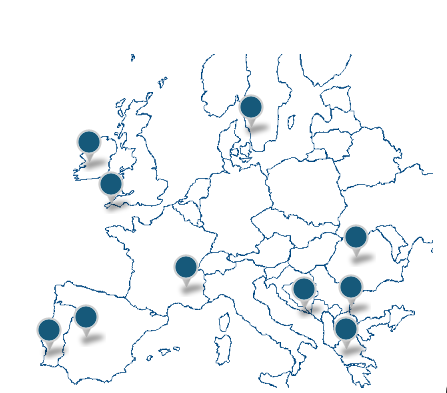
The interactive map is now online! This is one of HNV-Link’s largest outputs and would not have been possible without close collaboration among the 10 project teams during past 2.5 years. The interactive map showcases the innovation potential of HNV farmland areas and illustrates how the innovation needs of one area can often be met by innovations found within the same area and those from other HNV regions. Thus, the interactive map aims both to communicate about the HNV farmlands showcased and also to inspire transfer and adoption of innovations that support HNV farming.
Each learning area is showcased through photographs and pop-out texts in themes of Farming and Nature, Challenges, and Innovations. To facilitate cross-learning, each Learning Area lists the both the innovations of relevance from other project areas that could be applied to their local challenges, as well as issues for which it needs more innovations. If you are aware of potential solutions for the identified innovation needs, please, contact the Learning Area contact person.
The interactive map is suitable for a non-expert audience. It has a search feature where innovations can be found by several attributes. Go forth and explore!
HNV-Link’s educational materials
HNV-Link has completed another substantial and unique deliverable ‚Äď its educational materials about HNV farming and farmlands.
The Educational materials are envisioned to encourage educators in vocational and university levels to work more with this multifaceted topic. Advisors or farmers and farmer groups may also find them useful for exploring the farmed environment. Several of the assignments can be implemented in any farmland or farming system. Educators can use the materials as-is or adapt them. The ready-to-use slides may be used in people’s own presentations. The materials are Open Source under CC BY-NC-SA use for non-commercial purposes provided the project, its funding body and respective authors are acknowledged.
The materials include:
- 3 sets of slides:
- 4 sets of slides with cases from European countries:
- Dehesa farming systems of Spain , by Juan M. Domingo-Santos and Reyes Alejano (University of Huelva, Spain)
- Flood meadows in France, by Joséphine Pithon (ESA Angers)
- Abandonment impacts in Sardinia, by Emmanuele Farris (University of Sassari, Italy)
- Training conducted for farmers managing semi-natural grasslands in Latvia, by Solvita RŇęsiŇÜa (University of Latvia)
- a set of 10 assignments for work in class, field and farm. These can be adapted to any country or context and are produced (and tested) by experienced educators
The materials are accompanied by a database of resources on HNV farmland. It contains 74 items of links to videos, thematic websites and online presentations, as well as 46 titles of published reports and research papers (about half are open access).
HNV-Link is grateful to all the contributors who kindly provided presentations, assignments and images, and to everyone who gave feedback on drafts.
HNV-Link’s YouTube channel
HNV-Link has a growing collection of videos on its YouTube channel, organised in 3 playlists:
- About HNV-Link project.
‚Äď 6 videos from work package leaders and actors, including a popular slideshow The concept of High Nature Value (HNV) farming explained - Assessing the current situation in the activity areas of HNV-Link project.
‚Äď 12 videos on Learning Areas‚Äô Baseline Assessment - and Cross-visits.
‚Äď 11 short reflections on the cross-visits by both the host and visiting teams.
News from the Learning Areas
Croatia
October 1‚Äď4 A diverse team that included representatives of Croatian agricultural advisory services (AKIS), national beekeepers association, farmers and three Local Action Groups (LAG) had a very fruitful cross-visit to Tarnava Mare region in Romania. Everyone gained new knowledge relevant to own field. Frano Mihlinińá from AKIS got new from ideas for agri-environment measures for the Dalmatian Islands and will write a report for the national AKIS. Vlaho Komparak from the beekeepers association saw new possibilities for developing his own agribusiness based HNV farming. The LAG representatives met colleagues from other LAGs and experts from the ADEPT foundation, from whom they learned of new ways to inspire producer organisations in Croatia for developing local value chains.
May, June, September The Croatian team has held several regional meetings in LA Dalmatian islands to bring focus to the the high nature value farming in the islands and its specificities. The first meeting was held on the island of Brańć in May. It was organised as a stand-alone workshop within the fourth edition of an international conference on rural tourism, which attracted about 250 participants from 15 countries. Some 18 participants attended the workshop among them HNV farmers, AKIS actors (e.g. representatives of universities. EU MP‚Äôs), small food producers, representatives of LAGs and NGOs. Two Croatian members of HNVF-Link Advisory Board (Mrs. Sonja Karoglan Todorovińá and Mr. Filip Bubalo) also participated in the workshop. Mrs. Sonja Karoglan Todorovińá was moderating the workshop. Additional workshops were held on the islands of Korńćula, Hvar and Lastovo in May, June and September to foster the creation of a national HNVf islander network.
March Through a IAKS measure, Croatian farmers may now receive subsidies for maintenance of dry stone walls! More on this measure (in Croatian).
France
July 26 More than 30 people ‚Äď farmers, professional associations, advisors, local and regional authorities ‚Äď attended a regional meeting in Florac, France to discuss the key findings from the HNV-Link Baseline Assessment for Causses and Cevennes, work on innovations in the area and share local and European initiatives, experiences and success stories. They also identified collective actions to address the priorities for this Learning Area.
Ireland
The Irish team produced an excellent video about High Nature Value farming in the Burren and HNV-Link project. The video explains the concept of High Nature Value farming with the Burren as an example, the role of farmers in sustaining biodiversity, specific innovations developed to support farmers, HNV-Link project‚Äôs activities across Europe, and an HNV vision for the future ‚Äď all in 8:38 minutes!
‚ÄúThere‚Äôs a lot we can do in our own capacity as farmers in this gentle land...The cattle are very very important. When you have the cattle, you have the man, and you have the mountains. But one doesn‚Äôt work without the other. We‚Äôre all in it together. ‚ÄĚ ‚Äď Oliver Nagle, cattle farmer in the Burren, in "High Nature Value farmland in The Burren of Ireland"‚Äč
October 25‚Äď27 This year‚Äôs Burren Winterage School is an extended and enriched affair with this year‚Äôs theme of ‚ÄėFarming for Nature‚Äô. The Burren Winterage School is looking forward to welcoming several HNV-Link project colleagues from Sweden, the UK, Croatia, France and Romania. This year‚Äôs programme includes a workshop on HNV-Link innovations.
This year, the Farming in Conservation Awards, to be presented at the Burren Winterage School, are going national! The ‚ÄúFarming for Nature award‚ÄĚ is supported by a variety of partner organisations and volunteers. The main aim of the awards programme is to share the stories of farmers who are undertaking positive action for nature on their farms. It is hoped that highlighting these positive stories will inspire others to follow. Videos of the shortlisted candidates are here
Another irish initiative of relevance to HNV areas is the support provided by the Heritage Council and the Irish Uplands Forum to assist upland communities to carry out sustainable development projects in their local area. The work is informed by an uplands partnership management board of which James Moran (HNV Link LA coordinator Ireland) is a member. Upland areas in Ireland are dominated by HNV farmland with approximately 50% of the total area of HNV located within upland areas.
Portugal
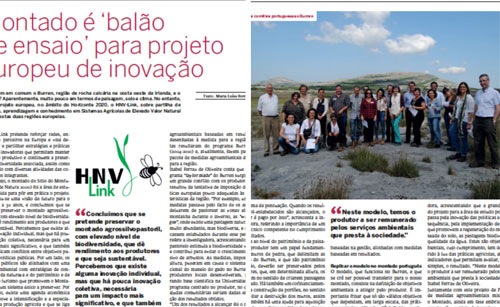
September HNV-Link and Learning Area Sítio de Monfurado have received Portuguese language media coverage! The September issue of Vida Rural, an agricultural magazine with a wide national circulation, published an article on HNV-Link and the Portuguese Learning Area of Sítio de Monfurado. The article also describes the team's cross-visit to The Burren, Ireland.
April HNV-Link also received coverage through an interview Isabel Ferraz de Oliveira gave on HNV-Link that was published in April in the Portuguese language National Rural Network magazine (page 42 and 43).
Romania
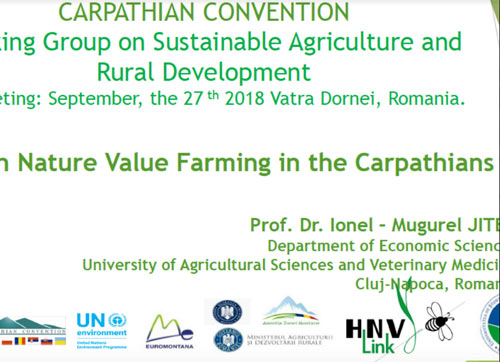
September 27 Mugurel Jitea, of the Romanian Eastern Hills of Cluj Learning Area, presented on High Nature Value Farming in the Carpathians at the 4th Meeting of the Working Group on Sustainable Agriculture and Rural Development at Vatra Dornei, Romania. Mugur presented HNV-Link’s results on trends, innovations and needs, with highlights from HNV-Link’s Baseline Assessments, Atlas, and Innovation Compendium. (See outputs).
Spain & Greece
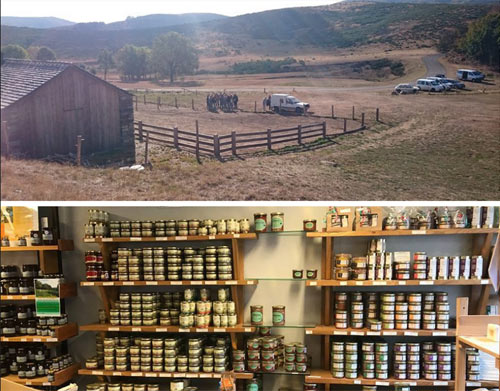
October The Spanish team and three Greek colleagues are back home after a very successful cross-visit to France in the first week of October. The main theme was supporting pastoral activity. They spent 3 days meeting pastoralists and people from the many different organisations involved in supporting pastoral activity in the area. The programme included visits to and with: 5 HNV farms, an abattoir run by farmers, small-scale on-farm cheese producers, agritourism, and a food processing and training centre for farmers. More about the cross-visit will be coming to www.hnvlink.eu/activities/cross-visits/
Spain
July 25 Media release and launch of Campo Grande Group agreements to reduce livestock-wolf conflict. HNV-Link partner Entretantos supported the process of Campo Grande Group for a series of agreements to promote coexistence of Iberian wolf and extensive livestock farming. The Declaration is a document of agreements reached after a long process of debate and collaborative building. Indeed, a main outcome of the work is the quality of the participatory process leading up to the agreements. The agreement itself is an invaluable example for the process to resolve a highly contested issue of conservation of a protected species that happens to impact negatively local livelihoods.
Sweden
October 25‚Äď27 After a successful funding application to the LAG group for travel assistance, the Dalsland group is excited to head to the Burren, Ireland for a cross-visit and to participate in Winterage School.
April and May HNV-Link’s Swedish partners presented the HNV farming vision for the Learning Area and information about HNV-Link to the municipal executive boards on each of the five municipalities of Dalsland.
The UK
September 26 HNV-Link funding enabled six farmers from Dartmoor and one farmer from Dorset visited Cholderton Estate in Wiltshire, UK. The purpose of the visit was to learn about the more drought resistant forage system that the estate owner and manager, Henry Edmunds, uses. This was particularly relevant following the dry summer that saw the grassland of the Dartmoor dry out. The farmers learned about the arable rotation and saw for themselves the rich abundance of flora and fauna on this nearly self-sufficient organic farm with dairy cattle, sheep and horse production. More on the visit here
Other projects to follow
HNV-Link partners contribute to other Horizon2020 projects through steering groups, cases, and more.‚Äč Here are links to some valuable projects that have already delivered:
PROVIDE project PROVIDE held its final Finnish conference on August 24th, where the Ruka-Kuusamo regional case study was presented and discussed with stakeholders. PROVIDE has also published their Policy Brief for 2018, which includes summary of the project‚Äôs final results. The project used a transdisciplinary approach to address the ‚Äúpublic goods and bads‚ÄĚ of agriculture forestry systems and governance mechanisms. The main results of the project are: (i) a renewed (‚Äúun-packed‚ÄĚ) conceptualization of the notion of public goods, (ii) an inventory of public good (and bad) provision in Europe, (iii) operational means for valuation and evaluation, (iv) a selection of evaluated governance mechanisms, and, finally, (v) a toolbox consisting of an operational framework to support the smart provision of public goods. Moreover, the project has set a starting point to establish a consolidated and hopefully long-lasting community of knowledge and practice.
SALSA project , with 25 European and 5 North African reference countries, aims to assess the role of small farms and small food businesses in delivering a sustainable and secure supply of affordable, nutritious and culturally adequate food. SALSA will identify the mechanisms which, at different scales, can strengthen the role of small farms and small food businesses in food systems and thereby support sustainable food and nutrition security.
SIMRA project SIMRA involves 26 organisations across Europe and the Mediterranean. The project has created an online catalogue that showcases 50 examples of social innovation in the fields of agriculture, forestry, and rural development. HNV-Link provided innovation examples for the database.
Many opportunities to get involved
- Check on the Interactive innovation map for needs of Learning Areas, and contact the contact persons if you know of innovation that addresses their needs.
- Download our outputs
- Consider using the Educational materials, testing assignments and providing feedback on them, or offering your own example.
- Follow us on social media and comment on the posts: Twitter, Facebook and YouTube
- Subscribe to the newsletter here
We are at www.hnvlink.eu.
Contact us:
@HNVLink on Twitter, Facebook, YouTube
This document reflects the author's view and the Research Executive Agency is not responsible for any use that may be made of the information it contains.

This project has received funding from the European Union Horizon 2020
research and innovation programme under grant agreement no. 696391
Back to news overview
